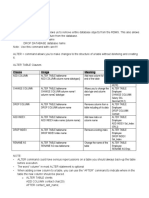0% found this document useful (0 votes)
16 views36 pagesScanario Based SQL
UNION merges two tables into one, omitting duplicates, while UNION ALL includes all records, including duplicates, leading to better performance. ANSI-standard SQL supports five JOIN types: INNER JOIN, LEFT JOIN, RIGHT JOIN, FULL JOIN, and CROSS JOIN, each defining how tables are combined based on matching criteria. SQL queries can produce unexpected results due to NULL handling and three-valued logic, necessitating careful construction to avoid issues.
Uploaded by
Utkarsh GuptaCopyright
© © All Rights Reserved
We take content rights seriously. If you suspect this is your content, claim it here.
Available Formats
Download as DOCX, PDF, TXT or read online on Scribd
0% found this document useful (0 votes)
16 views36 pagesScanario Based SQL
UNION merges two tables into one, omitting duplicates, while UNION ALL includes all records, including duplicates, leading to better performance. ANSI-standard SQL supports five JOIN types: INNER JOIN, LEFT JOIN, RIGHT JOIN, FULL JOIN, and CROSS JOIN, each defining how tables are combined based on matching criteria. SQL queries can produce unexpected results due to NULL handling and three-valued logic, necessitating careful construction to avoid issues.
Uploaded by
Utkarsh GuptaCopyright
© © All Rights Reserved
We take content rights seriously. If you suspect this is your content, claim it here.
Available Formats
Download as DOCX, PDF, TXT or read online on Scribd
/ 36






























































































